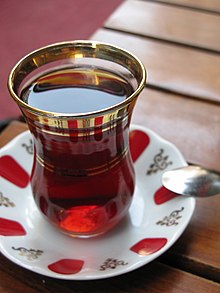Everyone here drinks tea. And there is lots and lots of culture and etiquette around serving tea in Turkey, so this is just going to be a super basic introduction. Tea is served in cafes and restaurants, alongside a snack or at the end of dinner. It's served in homes, in tea gardens (family and female friendly destinations) and tea houses (for the men to socialise in).

Photo credit: Wikipedia
Tea glasses are exactly that - small glasses with no handle, curved and transparent. They are usually held by the rim to avoid burning your fingers. Black tea is the standard tea (tea is actually grown in some parts of Turkey). The super sweet apple tea that tourists often come home with is not usually drunk by Turks! And it goes without saying that you don't drink Turkish tea with milk, although sugar is always offered.

A Turkish teapot or çaydanlık. The top part is for the strong tea and the bottom for the boiling water.
Photo credit: Wikipedia. I would have taken a photo of mine but I knocked it off the top of the fridge this evening and smashed the handle...
Tea is made using a Turkish tea pot, which is a two part tea pot. The bottom part is for boiling water, the top part is for the tea. My language helper insists that the tea (always in loose form for making Turkish tea, never tea bags) should be rinsed first to get rid of any powder in it. Then you put the tea (a generous tea spoon per person) in the top part (without any water) and stack it on top of the bottom part, which is filled with water. The water is then brought up to boil on the stove, at which point you add some of the water to the tea in the top part and let it steep for a while.
When tea is served, tea is poured from the top part of the tea pot - typically to about a quarter of the way up the glass, depending on how dark or light the drinker wants it. Then the strong tea is topped up with the boiling water.
A good host always keeps her guests' tea glasses topped up. My language helper's rule of thumb was that top ups of tea within 10 minutes can be made with the same water and tea, any longer and you need to reboil the water. And after 1-2 hours, a fresh pot should be made as guests have magic powers to be able to taste stale tea.
I'll admit now, we will serve Turkish tea if we have guests over (and even then sometimes they request 'English tea with milk' as they're with us) but for day to day life, we usually stick to tea bags (which can be bought here but aren't as strong as British ones) dunked in a mug of hot water, with milk. At least drinking black Turkish tea saves the argument about whether to add the milk or the water first!